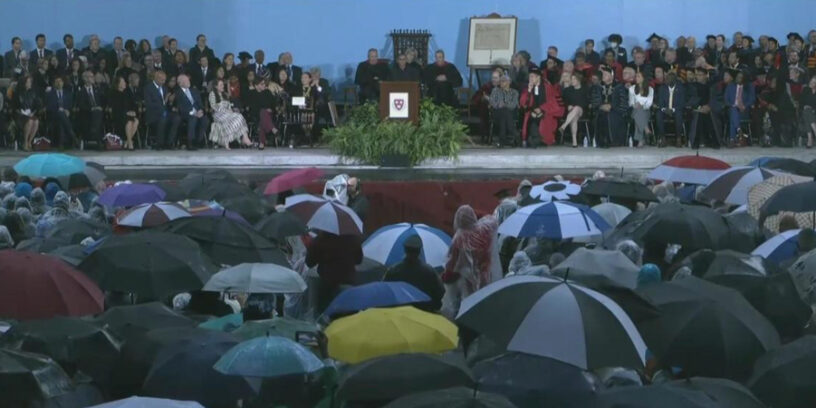“The Battle of Waterloo was won on the playing fields of Eton. The battle for America’s future will be won or lost in our nation’s community colleges and by the people who study within them.”
Harvard president emeritus larry summers
addressing students at Northern essex community college
NOTE: This article originally appeared in the March 5, 2024 edition of Commonwealth Beacon and the March 5, 2024 edition of Community College Daily.
Last September, I sat in the pouring rain and mud puddles of Harvard Yard alongside hundreds of other higher education leaders and thousands of drenched spectators sporting plastic ponchos and pop-up umbrellas, at the inauguration of the vaunted university’s 30th president, Claudine Gay.
President Gay’s inaugural address that day was titled “Courage to be Harvard,” and it was a passionate entreaty to the students, faculty, and staff of the world’s most recognizable college for curiosity and broad-mindedness in the name of innovation and achievement.
“We believe in the value of dynamic engagement and the learning that happens when ideas and opinions collide,” Gay insisted, “Communities that welcome diverse perspectives thrive not because they endorse all as valid but because they question all on their merits.”
The speech was soaring and uplifting, even if the weather was not; but it belied an uncomfortable reality about campus life at Harvard: Just before inauguration day, the Foundation for Individual Rights in Education (FIRE) announced that Harvard had received the “worst score ever” in their annual “College Free Speech Rankings,” a 0.00 (actually a -10.69) out of 100.00 possible points, coming in 248th, dead last on the list.
Among the concerns driving the abysmal showing were widely publicized episodes of disruptive conduct, like students shouting down speakers invited to campus; the university’s sanctioning or termination of scholars publishing controversial viewpoints; and overly vague speech policies that could be used to stifle free expression.
Then, things got even worse.
Two months later, President Gay sat alongside MIT’s President Sally Kornbluth and the President of the University of Pennsylvania, Liz Magill, at a Congressional hearing on antisemitism on college campuses, in the wake of pro-Palestinian student demonstrations that followed Hamas’ October 7 attack on civilians in Israel.
It was a disaster.
Republicans at the hearing, led by House Committee on Education and the Workforce Chair Virginia Fox (R-NC) and Representative Elise Stefanik (R-NY) grilled the trio of presidents from three of America’s most elite institutions for more than five hours about their policies, student behavior, DEI initiatives, and, most importantly, whether and how they protected the rights and guarded the safety of Jewish students on their campuses.
In one of the hearing’s most miserably memorable moments, Representative Stefanik asked President Gay, “At Harvard, does calling for the genocide of Jews violate Harvard’s rules of bullying and harassment, yes, or no?”
Gay’s now infamous answer (and the answer similarly provided by the other presidents on the panel) was, “It can be, depending on the context.”
Legally speaking, President Gay was correct; but it was most certainly not the answer Representative Stefanik, or most of America, was looking for.
Four days after the hearing, Penn’s President Magill resigned. Four weeks after the hearing, and after numerous public allegations of plagiarism in her published research, on January 2, 2024 President Gay also stepped down, after serving for only six months and two days, the shortest tenure of any president in Harvard’s history.
Looking back, the downpour at President Gay’s September inauguration and the stormy reception of the three presidents at the December Congressional hearing set the tone and direction not just for Gay’s short-lived presidency, but for all of higher education in 2024.
This is a tumultuous time for America’s colleges and universities.
Poll after poll shows eroding trust and confidence in higher education.
The rising cost of college attendance and flattening salaries in many career fields have slightly more than half of Americans questioning the value of degrees.
And even traditional liberals are beginning to wonder whether progressive ideology, or “wokeness,” on college campuses has gone too far, and become its own form of discrimination and free speech suppression.
Despite all this doom and gloom, I’d like to offer two important things to keep in mind:
- America’s opinions about higher education are disproportionately influenced by what happens on the campuses of a handful of the most elite, expensive, largely East coast institutions, like Harvard, MIT, Columbia, Brown, and the University of Pennsylvania. Nearly every story you see on cable news (or on your TikTok feed) are about campuses like these.
- These universities do not represent all of American higher education, especially the nation’s community colleges.
To put it more bluntly: Community colleges are not Harvard—and that’s a good thing.
Here are just a few reasons why:
Community Colleges Are America’s “Open Door” Institutions
While elite institutions like Harvard, Columbia, and Stanford loudly boast about the number of applicants they reject each year (average acceptance rate: 5%), community colleges are America’s “Open Door” institutions, and proudly proclaim that they admit everyone (average acceptance rate: 100%).
As a recent New York Times study illustrates, only 23 colleges in the nation admit fewer than 10% of applicants, accounting for just 139,000 students.
Community colleges, meanwhile, enroll nearly 9 million, outnumbering students at elite institutions 65 to 1.
So, if you want to understand what campus life is really like at America’s colleges today, visit your local community college, not Harvard.
Community Colleges Are Affordable
According to the College Board, the average annual cost of tuition, room and board at all private, non-profit colleges in the country has climbed to around $40,000.
Here in Massachusetts, as the Boston Business Journal reported last fall, fourteen of those private colleges now cost an astonishing $80,000 a year or more.
Americans collectively owe about $1.6 trillion in student loan debt. While barely a quarter of students attend private universities, the ones who do owe half of all that debt.
Meanwhile, the average annual cost of attendance at a public community college is around $4,000. Only 12% of community college students take out federal Direct Loans, and the average amount they owe is less than $10,000.
With most states offering “Early College” experiences for high school students, and more than thirty states (including Massachusetts) offering some version of tuition-free community college degrees, the cost of attendance—including transferring to a four-year university to complete a bachelor’s degree—keeps going down.
Community Colleges Provide a Bigger Boost
According to the Opportunity Insights project, some of the best colleges in the world seem to have very little impact on whether their students climb the socioeconomic ladder, mostly because they are already a rung or two from the top; while community colleges like NECC are far better at serving disadvantaged students and helping them reach upward mobility.
In this online article from the New York Times, you can search for and see the profile of every college and university in America—the kind of students it serves, and how successful they are at helping lower income students reach the middle class.
Try it out for your alma mater, or click here to see the profile for Northern Essex Community College, and here are some of the things you will learn about us:
- The median family income for our students is $52,900, among the lowest in Massachusetts.
- About 18% of our students are from the bottom 20% income percentile, among the highest proportion in the state.
- After their education, 20% of our students move up two or more income percentiles, one of the best improvement rates in the Commonwealth.
In fact, out of 76 colleges and universities in Massachusetts, NECC is 14th, while Roxbury and Bunker Hill Community Colleges arrive at 2nd and 3rd at helping students pursue the American Dream, and find careers, incomes, and lives for themselves better than where they started.
Tufts, Boston College, Harvard, and most of the other elite universities? They lag way behind in 64th, 70th, and 71st place. Only about 11% of their students manage to move up two or more rungs on the socioeconomic income ladder.
Community College Students Balance Civic Engagement with “Real World” Responsibilities
Last November, a few weeks after Hamas’ terrorist attack on Israel, WBZ News in Boston ran this story about students demonstrating loudly, taking over buildings, violating campus policies, and making other students feel unsafe: “Tensions running high at East Coast college campuses over Israel-Hamas war protests.”
Before watching or reading the story, you can likely name most of the colleges involved: Tufts, MIT, Brandeis, Brown, and Columbia.
Noticeably absent from the list are Bunker Hill, Roxbury, Mass Bay, Northern Essex, or any of the other fifteen community colleges in Massachusetts (or dozens more in neighboring New England states).
Elite university campuses and their students have indeed developed reputations for extreme progressive ideology, shouting down speakers they disagree with, staging classroom walkouts, disruptive administration building sit-ins, and even hunger strikes, leading Harvard Professor and Washington Post columnist Danielle Allen to acknowledge, “We’ve Lost Our Way on Campus; Here’s How We Can Find Our Way Back.”
Meanwhile, community colleges and our students reflect the full range of political identities in the communities we serve and have largely avoided the high-profile conflagrations occupying the time, attention, and resources of elite campuses.
It’s not that community college students are uninterested in politics and current events.
Here at NECC, over the past few months, we have hosted respectful forums with presidential candidates like the former Republican Governor of Arkansas Asa Hutchinson, and an entirely peaceful, standing-room-only lecture called “Israel and Gaza: Untangling the Histories,” in which one of our longtime history professors sought not to take sides in the generational conflict, but to explain its various roots to a new generation.
After graduation, our highly engaged alumni have become congressional aids, national award-winning journalists, and high-ranking government officials.
Far from being uninterested, community college students must weigh when and how they choose to engage in politics and current events the same way most normal Americans do: by considering their priorities, available time, competing responsibilities, and the consequences of their actions.
Nearly all students at elite universities attend full-time, often living on campus, and working, if at all, a handful of hours each week.
While a selling point for many elite universities is the opportunity they provide students to experience the “real world” of work through internships, fellowships, and cooperative education experiences, most community college students are already seasoned veterans of that “real world,” working an average of 30 hours each week, frequently at multiple jobs, and sometimes on top of caring for children and other family members.
Since most community colleges do not have dormitories, rather than live on campus, our students commute each day, sometimes from neighboring cities or towns miles away.
Between commuting, classes, studying, and job and family responsibilities, perhaps it is not surprising that community college students are rarely rounded up in after-hours arrests of disruptive sit-ins, though they may well have strong opinions about current events that they express in other ways, such as starting a foundation for people with disabilities, helping to save endangered species, or simply voting (NECC has been named an “All In Most Engaged Campus for Student Voting” for our high turnout rates).
Community Colleges Stretch Donor Dollars Further
In case all this has you thinking differently, and more generously, about community colleges, and perhaps making a contribution yourself, let me offer this encouragement: Community colleges stretch donor dollars much further.
Most elite universities already have some pretty big savings accounts. MIT’s endowment currently sits at $27.4 billion. The University of Pennsylvania has $20.5 billion, and while Brown’s trails behind at only $6.5 billion, folks, that’s still billion with a “B.”
Harvard University’s endowment, valued at just over $53 billion, is larger than the economies of 120 nations(two-thirds of the countries on the planet).
So, if you decide to write them a check—let’s use $1 million just to keep it simple—your donation to the Harvard Crimson would increase the heralded university’s endowment by a barely noticeable .000019 percent.
That’s not a major gift, it’s a rounding error.
While the overwhelming majority of their students come from wealthy families (rich students at Harvard University outnumber low income students 23 to 1), the university does offer generous financial aid to the low-income students it admits. For example, students from families with annual income of less than $85,000 pay nothing.
Assuming a typical 5% average rate of return on the $1 million you sent them, your donation would generate about $50,000 a year—not even enough for one student’s full academic scholarship, since the cost of tuition and fees at Harvard climbed to $59,276 this year.
Meanwhile, NECC is recognized as a “public” college in the state of Massachusetts; but the reality is that only about a third of our funding comes from the Commonwealth. Student tuition and fees, along with grants, fundraising, and creative revenue sources like corporate training and facilities rentals make up the rest.
Our funding is two-thirds private.
And, like most community colleges, we have a relatively modest endowment—just over $9.5 million as of this afternoon.
That means your $1 million donation to the NECC Foundation will increase our endowment by more than 10%.
That’s a game changer.
While the cost of attending a community college in New England is somewhat higher than the national average, here at NECC we are still a modest $6,800 a year for tuition and fees.
The majority of our students come from low-income backgrounds and are eligible for sizable awards from the federal government known as Pell Grants, in addition to state aid like Mass Grants. So, after receiving this additional support, most of our students pay around $1,000 a year.
That means the $50,000 your $1 million gift generates will cover the total cost of an associate degree for around fifty students every year.
Down in Cambridge, your contribution may appear in small print as a footnote in the annual ledger of thousands of dutiful donors.
But up here in the Merrimack Valley, where a million dollars still means a lot, your name will be in the hearts and minds of the thousands of people whose lives you’ve changed for the better.
And if you’re interested, we’ll even name a building for you—take your pick.
Coda
A few years ago, Harvard President Emeritus and former United States Secretary of the Treasury Larry Summers visited the campus of Northern Essex Community College to speak with our students about challenges facing the country, his optimism for our future, and the important role community colleges and their students can play.
He explained that the Duke of Wellington famously said, “The Battle of Waterloo was won on the playing fields of Eton,” referring to the English boarding school attended by generations of wealthy British nobles.
However, Summers added, “The battle for America’s future will be won or lost in our nation’s community colleges and by the people who study within them.”
America’s elite universities, like Harvard, are one of our greatest assets, a shining beacon, attracting students from all around the world, conducting vital research in every area of human endeavor, and producing many of our nation’s best-known leaders.
But they do not represent all of American higher education, particularly our uniquely American invention: community colleges.
And that’s a good thing.






